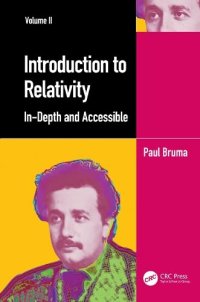
Ebook: Introduction to Relativity: In-Depth and Accessible
Author: Paul Bruma
- Genre: Physics // Theory of Relativity and Gravitation
- Tags: Lorentz Transformation, Relativistic Laws of Dynamics, General Relativity, Cosmological Models
- Year: 2022
- Publisher: CRC Press
- City: Boca Raton, FL
- Edition: 1
- Language: English
- pdf
E=mc² is known as the most famous but least understood equation in physics. This two-volume textbook illuminates this equation and much more through clear and detailed explanations, new demonstrations, a more physical approach, and a deep analysis of the concepts and postulates of Relativity.
Volume II contains, notably:
- In Special Relativity: complementary explanations, alternative demonstrations relying on more advanced means and revealing other aspects. Further topics: accelerated objects and the Relativistic force, nuclear reactions, the use of hyperbolic trigonometry, the Lagrangian approach, the Relativistic Maxwell’s equations.
- In General Relativity: tensors, the affine connection, the covariant derivative, the geodesic equation, the Schwarzschild solution with two of its great consequences: black holes and the bending of light; further axiomatic considerations on time, space, matter, energy and light speed.
- In Cosmology: the FLRW Metric, the Friedman equation, the cosmological constant, the four ideal cosmological Models.
These subjects are presented in a concrete and incremental manner, and illustrated by many case studies. The emphasis is placed on the theoretical aspects, with rigorous demonstrations based on a minimum set of postulates. The mathematical tools dedicated to Relativity are carefully explained for those without an advanced mathematical background.
Both volumes place an emphasis on the physical aspects of Relativity to aid the reader’s understanding and contain numerous questions and problems (147 in total). Solutions are given in a highly detailed manner to provide the maximum benefit to students.
This textbook fills a gap in the literature by drawing out the physical aspects and consequences of Relativity, which are otherwise often second place to the mathematical aspects. Its concrete focus on physics allows students to gain a full understanding of the underlying concepts and cornerstones of Relativity.